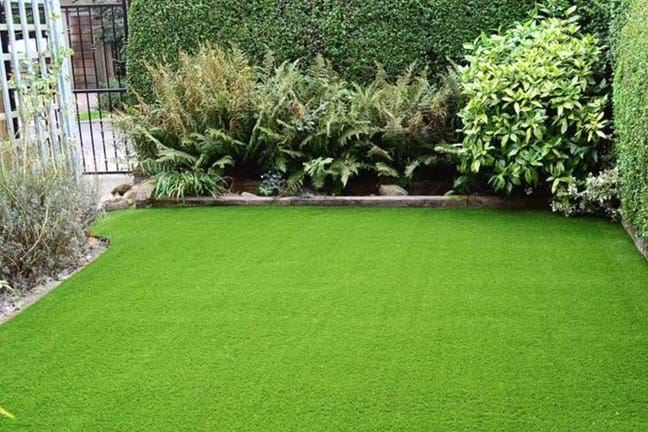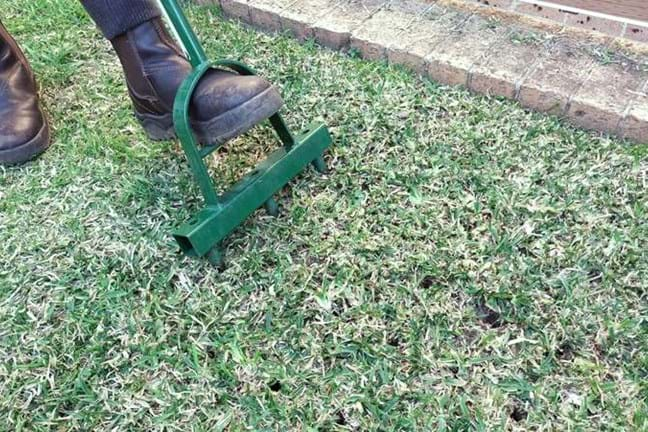
From brown patches to thinning grass, established lawns often need a bit of a boost to stay lush and green. It doesn't take much to give your lawn some TLC and bring back soft, even turf that you're proud of. Before beginning, check your lawn for soil pH issues and lawn pests as these can hold the lawn back. If these aren't an issue, then follow our four-week plan to luscious lawns. Here's Your Four Week Lawn Restoration Plan...

WEEK 1 - Weed Control
Start your lawn in the right direction by eradicating weeds that can make it bristly, scratchy and uneven. Control broadleaf weeds such as clover, dandelions and thistles by applying Yates Weed'n'Feed Hose-On onto kikuyu and couch lawns. With an added fertiliser, it will keep your grass healthy while getting rid of weeds. To control weeds in buffalo grass, use Yates Buffalo Pro Weed'n'Feed Hose-On. Specially formulated for buffalo grass, it kills broadleaf weeds, while keeping the lawn lush and green.

WEEK 2 - Scalp
The main reason for scalping a lawn would be to remove old yellow hard growth and allow for soft new green growth.
Scalping is the most common “renovation” process because you most likely already own the tools required for it. You can complete the process using your lawn mower by mowing the lawn and lowering the mower on each subsequent cut across the entire area until you have removed all signs of green growth & the entire area is brown.
It may take a few attempts to get the right amount of scalping for your lawn, but a good rule of thumb is be super aggressive on kikuyu and couch, less aggressive on Blue Couch and buffalo and gentle with cool season grasses (unless you are choosing to thicken by oversowing as part of the renovation).
You may need to lower the mower and cut your lawn 3–5 times (or more) in the one session (this can be done on the same day). You do not want to lower your lawn mower too much on the first cut if your lawn is long as this will clog the mower and be difficult to cut.
Make sure you catch and remove clippings, so they don't add to the thatch. If a lot of clippings remain it is best to rake them up.
After mowing, apply soil wetting agent Yates Waterwise Soil Wetter Hose-On to help encourage better water penetration into the soil.

WEEK 2 (continued) - Aerate
Compacted soil limits the amount of nutrients and water that can penetrate the grass roots. By aerating an established lawn, it can loosen the soil and allow water, nutrients and air to be absorbed more deeply. This allows for deeper root development and a healthier more drought tolerant lawn.
Aeration can be completed using a mechanical or inexpensive hand corer. Hand corers are great for small lightly compacted areas, but it is highly recommended to use mechanical methods for areas that are large or heavily compacted. Mechanical corers can be hired, or a contractor organised to do the job. Cores should be made every 2.5 x 5cm.

A hollow coring tine pulls soil plugs from the lawn, the process of doing this not only puts holes in your lawn but pokes holes in any accumulated thatch area. For warm season grasses these cores contain growing parts of the grass plant and so can be transplanted into bare areas to help re-establish these areas. For cool season grasses, it is better to re-establish these areas from seed.

WEEK 3 - Topdress
Top dressing is utilized for smoothing or levelling turf as well as filling holes produced by coring.
Top dressing soil should be clean, free of pests, weeds and rocks. A top dressing needs to filter through the leaf blades so needs to be fine like a medium sand or a loamy sand such as 80/20. Spread the soil as evenly as possible over the area and rub in using the back of a rake, broom or ideally a level on the lawn.
For those wanting to oversow, this is the time to resow your lawn seed and water deeply.
WEEK 4 - Feed
Kick your lawn into gear and produce lovely new green growth by feeding it with Yates Dynamic Lifter Concentrated Lawn Food. This concentrated lawn fertiliser containing fast acting nutrients and slow release organics. Its blend of fast acting nutrients, including sulphur, calcium, nitrogen, phosphorous and potassium, promote long-term soil health while also helping your grass green and thicken quickly.








